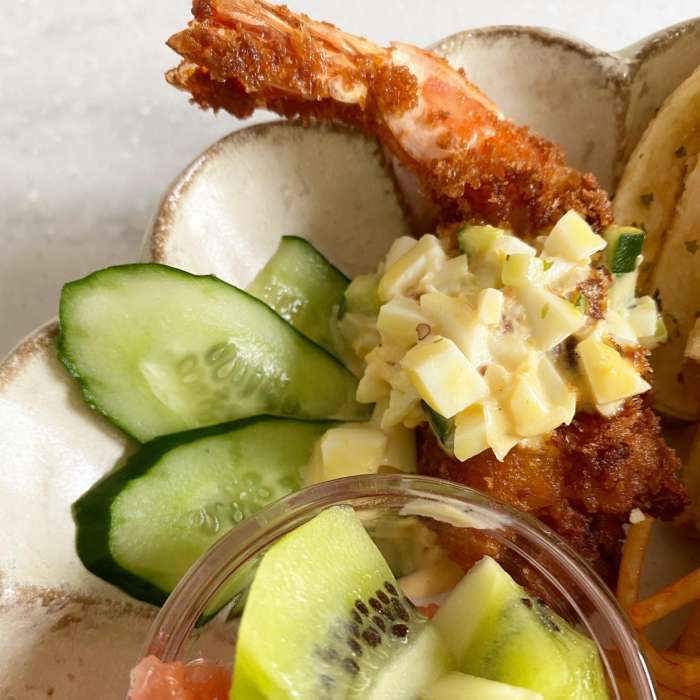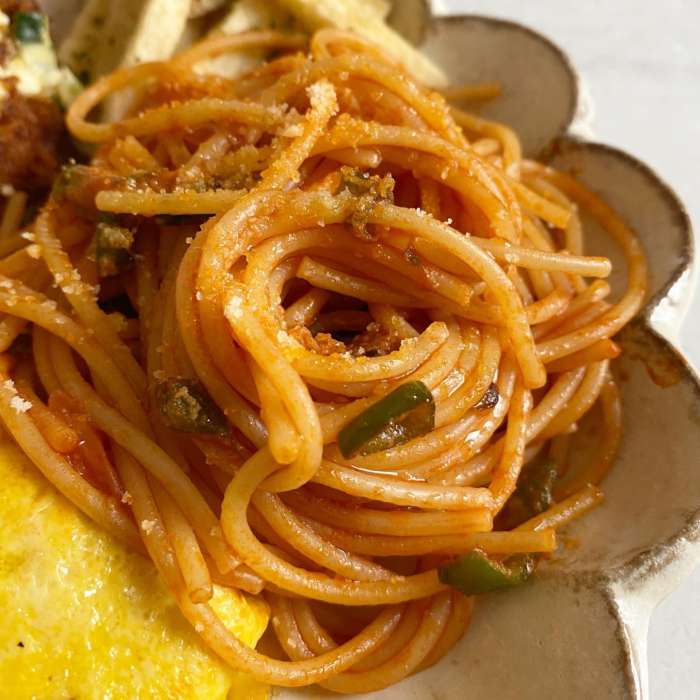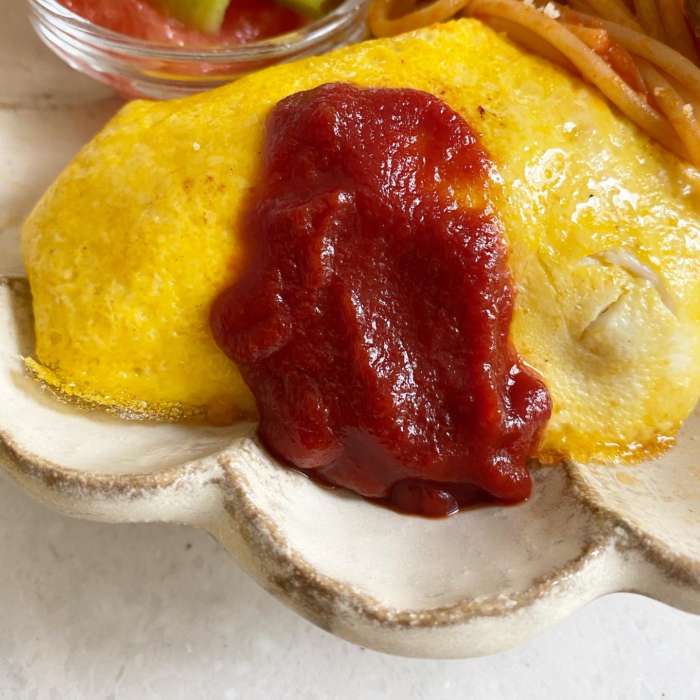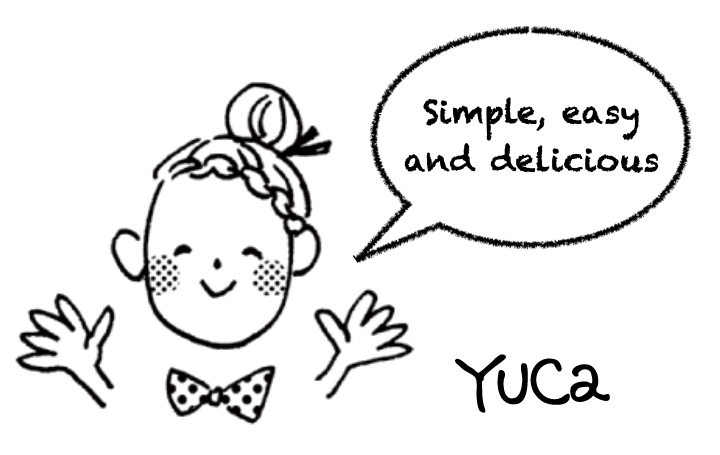Yoshoku (Japanese-style Western Food) 洋食

Yoshoku (洋食) is western food adapted to the Japanese palate. This style of cuisine started in the Meiji restoration period, 1868-1012, when, after centuries of isolation, Japanese citizens began traveling to other countries and learning about the cuisine outside of Japan. So, Yoshoku also means uniquely developed Japanese-style western dishes.
The classic Yoshoku dishes includes curry rice, ebi fry (fried shrimp), and Korokke (croquette made with potatoes and meat). Some of these influences are reflected in the popularity in Japan, of sauces such as ketchup or Worcestershire, as well as bread.
Yoshoku has a special appeal of nostalgia to the Japanese. It is an icon of the Showa period, and the never-changing taste of the classic dishes bring back people’s memories. A great place to feel the nostalgia is authentic Koshoku restaurants called “Yoshoku ya” (洋食屋) or “Yoshoku ten” (洋食店).
You can αlso eat Yoshoku dishes in other places, too. Family restaurants called “Famiresu” are casual and inexpensive chain restaurants. Okosama lunch is a popular item at famiresu. It is a plate of selected Koshoku dishes specially made for children. Some of the Japanese-style cafes called “Kissaten” (喫茶店) serve yoshoku dishes too.
Most Yoshoku dishes will be eaten with silverware instead of chopsticks, rice at Yoshoku restaurant is served on a plate instead of in a rice bowl.
Popular Yoshoku menu items:
Ebi Furai(エビフライ)Breaded and deep-fried shrimp [Recipe]

Napolitan (ナポリタン ) Spaghetti with ketchup based sauce [Recipe]
Napolitan is a classic Yoshoku dish made with spaghetti and a ketchup-based sauce. The sauce is typically is made with ketchup, onion, green pepper and mushrooms. Julienned ham, bacon or sausage is also added to the sauce.
It is normally served with grated parmesan cheese. The texture of the noodles is originally soft, but you can find firmer “al dente” nowadays.
It is said that this dish was invented after World War II by a chef in Yokohama who saw American soldiers eating spaghetti seasoned with ketchup instead of tomato sauce. Later, he improved the taste by using fresh tomatoes, and this legendary dish was born.

Omu rice(オムライス) An omelet willed with ketchup-flavored rice
Omu rice means “omelet and rice”. Flavored rice is wrapped in a thin sheet of omelet. It is shaped into an oval. Making a thin yet solid sheet of eggs is challenging for cooks. The rice is flavored with ingredients, such as chicken stock, onion, ketchup and butter. The sweetness of ketchup and onion complement the flavor of chicken.
Omu rice is also topped with ketchup. Cutting into the just-plated omu rice, you will enjoy the aroma coming out of the warm flavored rice inside.
There are variations of omu rice. The topping can be demi-glace sauce or bechamel sauce instead of ketchup. Omu curry is omu rice plated together with Japanese curry. Omu soba is noodles wrapped in a sheet of omelet instead of rice.

Hambagu(ハンバーグ)A meatloaf-like burger served with demi-glace sauce, but without a bun [Recipe]
Hambagu is a steak of a round or oval-shaped patty made with ground beef, onions, eggs and breadcrumbs. The meat may be a blend of beef and pork.
The name hambagu is said to have come from the dish made in the German city of Hamburg in 18th century. The original dish was brought to the US by German immigrants and became Hamburg steak. The Japanese eventually adopted it to their diet.
There are variety of sauces for hambagu. A blend of ketchup, oyster sauce and Worcestershire sauce is common. Other popular sauces include soy sauce and grated daikon radish, demi-glace and teriyaki. Hambagu may be topped with mushrooms, cheese, or a sunny-side egg. It is often served with rice or spaghetti.
Other Yoshoku menu items:
Kare-raisu (カレーライス) Curry with rice [Recipe]
Korokke (コロッケ) Creamy croquettes, sometimes filled with seafood such as crab
Menchi Katsu(メンチカツ) Breaded and deep-fried hamburger to which chopped onions have been added
Omuretsu(オムレツ) Omelet
Guratan(グラタン)Gratin dishes often macaroni or seafood in cream sauce with cheese
Doria (ドリア) Rice casserole with a white sauce
Hayashi raise (ハヤシライス) Beef stew in a demi-glace sauce
Bi-fu shichu (ビーフシチュー) Beef stew
Bi-fu sute-ki(ビーフステーキ) Beef steak
Roru kyabettsu(ロールキャベツ)Cabbage rolls with tomato sauce
Memo :
1. Are you looking for Japanese cookbooks and kitchenwares etc? Visit YJC store on Amazon!
2. Would you like to cook many more recipes? Download Free recipe app from here! “Recipe by YJC”
* Reference of this article : Food Sake Tokyo (The Terroir Guides) , 外国人がいちばん食べたい和食90選









